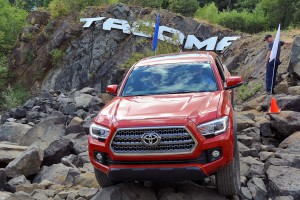
Toyota's new 2016 Tacoma is designed to be a very capable off-road machine with an improved suspension and more powerful engine.
Once upon a time, Toyota touted the Tacoma as an answer to the larger pickup trucks built by Ford Motor Co., General Motors and the old Chrysler Group.
The strategy fell apart, but the Tacoma found its niche anyway. Thanks to the strength of the company’s dealer network in the western U.S., it has earned the loyalty of a substantial group of buyers looking for a durable truck that’s a bit smaller than a Ford F-150 or Chevrolet Silverado and capable of going off road.
The introduction of the 2016 Tacoma underscores the growing competition in the midsize truck segment where the new Chevrolet Colorado and GMC Canyon have made a big splash and a new Nissan Frontier will appear soon.
With the introduction of the new Tacoma, Toyota is trying to amplify and broaden the appeal of the truck with new technology, which enhances the truck’s off-road performance, a new engine and a new cabin that is far quieter than the older versions of the truck.
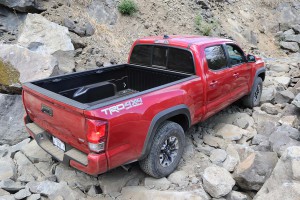
The 2016 Toyota Tacoma is designed to be a tough, off-road machine with plenty of interior refinement.
The exterior also has been updated both front and back, while the truck’s silhouette presents a nice and more contemporary appearance that includes a character line running down the length of the vehicle and a new hood scoop. LED daytime running lights are now standard and angle LED fog lights can be added.
While the Tacoma has retained drum brakes on the rear wheels, the overall ride and handling has been improved as the steering is sharper and the ride smoother thanks to the changes in the suspension layout. But the big improvement in driving the Tacoma came from the relatively quiet cabin. You still pick up some tire noise on various surfaces, but overall the improvement was noticeable and I am a big believer that quiet cabins reduce driver stress and fatigue. You could also hold a conversation and/or listen to music.
The interior itself has been upgraded with the addition of soft material. It’s not everywhere, but it is still a major improvement over the cabins of the older versions of the Tacoma, which seemed to the furnished almost exclusively in plastic. The architecture of the instrument panel, while relatively spare, brings all of the key controls, including the controls on the entertainment system, within easy reach. The instrument cluster is also nicely and complements the good visibility from the driver’s seat.
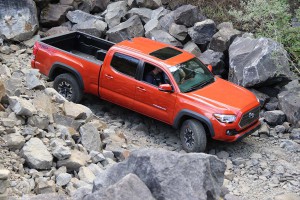
The Tacoma is equipped with a new system that can help take the truck up or down a steep grade at a slow steady pace all by itself.
(Toyota expecting only modest growth from new Tacoma pickup. For more, Click Here.)
The Tacoma also is equipped with the tilt and telescoping steering wheel that the driver can adjust for comfort.
The key attribute of the Tacoma, however, is its ability to go off road. The Tacoma has earned a reputation for being a capable truck out in the bush and Toyota’s engineers sought to enhance the trucks off road capability. The Tacoma is equipped with a new system that can help take the truck up or down a steep grade at a slow steady pace all by itself. The driver doesn’t have to touch the brake or the gas pedal all they have to do is steer.
Not all Tacomas are equipped with four-wheel-drive, but all Tacomas are equipped skid plates under the engine block and underneath the gas tank in the rear of the vehicle, which means every Tacoma is ready to step off the pavement if the driver desires. The truck and its suspension do well in leveling out the bumps even on deeply rutted roads and the 4×4 version of the Tacoma is equipped with an automatic slip differential that enhances the off-road driving dynamics.
(Click Here for details about Toyota’s new small crossover.)
Toyota is offering two different engines in the Tacoma, but the versions I drove were equipped with the new 3.5-liter V6 with 265 horsepower and 240 foot pounds of torque. The powertrain also included a new six-speed automatic transmission. On the straightway the truck had plenty of power, but it seemed to labor a bit climbing a steeper hill or even freeway exit ramp. The engine’s performance left the impression the engine couldn’t produce quite enough torque to climb as the automatic transmission downshifted.
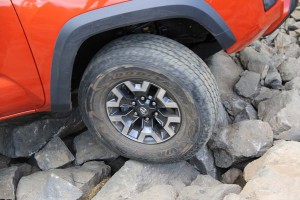
The Tacoma has a slew of new electronics and a more comfortable interior, but the key attribute of the Tacoma is its ability to go off road.
The 3.5-liter engine, however, does have a self-cleaning feature that keeps the fuel injectors working at the optimal level.
The 2016 Tacoma is also equipped with up-to-date technology such as a rear-backup camera and can be equipped with Toyota’s “Etune” premium audio and navigation system.
Over the years, the Tacoma has earned a reputation for versatility and durability that have given its used truck one of the highest resale values of any vehicle sold in the U.S., which is most impressive.
(To see more about Toyota has been impacted by the explosions in Tianjin, China, Click Here.)
When you come right down to it, Toyota has employed a simple formula for the Tacoma. It is a basic no frills truck with enough size to carry cargo and agility to go off road in demanding country for fun of all sorts. But simplicity has an enormous appeal.

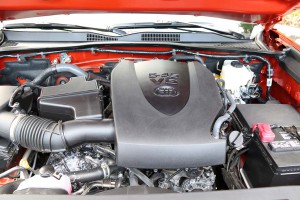
Article does not mention manual transmission, or off road performance in low-4WD. 265 HP should be plenty, of course the power curve is important. I would want to see more thorough reviews before I get excited about it. I really like my 2011 Tundra 4WD, though.
Looks like the usual progressive refinements to a pretty decent small pickup truck… nothing major, nothing earth-shattering, just a freshening of a proven performer.
Rear drum brakes on a fresh model in 2016 isn’t much of a thrill, though. I have no idea why any manufacturer would still install drum brakes any more; disc brakes are inherently simpler, much more effective, and in my estimation, cost-competitive with a cheap drum setup. What’s the next “improvement,” inner tubes? >:-(
Drum brakes = lower cost though I agree in today’s market it’s not a wise move. Can’t understand however why the 3.5L 265 HP / 240 lb-ft torque engine would be weak on power for exit ramps or hills unless the gearing is unusual tall requiring the downshift to a more appropriate gear for inclines. Everyone is looking for maximum EPA mpg ratings so the gearing may be less than optimal?